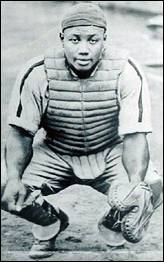

By Larry Schwartz
Special to ESPN.com
Often it is difficult to distinguish fact from fiction -- especially regarding statistics -- when it comes to players of the Negro League. But there is no disputing the accomplishments of Josh Gibson, whose batting feats are legendary.
 | |
| Before dying at age 35, three months before Jackie Robinson's major-league debut, Josh Gibson had proven to Negro League followers that he was one of the game's greats. |
Gibson is often referred to as the black Babe Ruth for his ability to hit tape-measure homers, and he also hit for incredibly high averages.
"He hits the ball a mile," Hall of Famer Walter Johnson, the Washington Senators pitcher who won 416 games, said of Gibson.
Satchel Paige, who was Gibson's teammate on the Pittsburgh Crawfords and later pitched for the Cleveland Indians, said, "He was the greatest hitter who ever lived."
In various publications, the 6-foot-1, 215-pounder has been credited with as many as 84 homers in one season. His Hall of Fame plaque says he hit "almost 800" homers in his 17-year career. His lifetime batting average was higher than .350, with one book putting it at .384, best in Negro League history.
It was reported that he won nine home-run titles and four batting championships playing for the Crawfords and the Homestead Grays. In two seasons in the late 1930s, it was written that not only did he hit higher than .400, but his slugging percentage was above 1.000.
Belting home runs of more than 500 feet was not unusual for Gibson. One homer in Monessen, Pa., reportedly was measured at 575 feet. The Sporting News of June 3, 1967 credits Gibson with a home run in a Negro League game at Yankee Stadium that struck two feet from the top of the wall circling the center field bleachers, about 580 feet from home plate. Although it has never been conclusively proven, Chicago American Giants infielder Jack Marshall said Gibson slugged one over the third deck next to the left field bullpen in 1934 for the only fair ball hit out of the House That Ruth Built.
Gibson was born Dec. 21, 1911 in Buena Vista, Ga., and his family reportedly moved to Pittsburgh in the 1920s. By the time he was a teenager, Gibson was playing semipro baseball. His professional career began at the age of 18 under unusual circumstances.
 |
|
| Previous poll results |
"I asked him if he wanted to catch and he said 'yes, sir,' so we had to hold up the game while he went and put on Buck Ewing's uniform," Johnson said. "We signed him the next day."
Gibson played for the Grays the rest of that season and 1931, before jumping to the Crawfords and winning three home-run titles in five seasons. He caught Paige in 1936 to form the most popular battery in African-American history. After starting 1937 in the Dominican Republic, he returned in the summer to play for the Grays.
He won two more home-run titles, in 1938 and 1939, as well as a batting championship in 1938. There are stories that the Senators and Pittsburgh Pirates considered giving the powerful catcher a tryout in the late '30s, but because of the color of his skin he was never granted the opportunity.
In 1940 and 1941, he chose to play south of the border, undoubtedly because of greater financial rewards. After starring for Vera Cruz of the Mexican League, he played in the Puerto Rican Winter League, earning Most Valuable Player honors and a batting title. Gibson was forced to abandon the Mexican League and return to the Grays in 1942 after the team's owner, Cum Posey, hit him with a lawsuit. Gibson led the Negro League in hitting and home runs.
Early the next year, Gibson suffered a brain tumor that put him in a coma. When he awoke, doctors wanted to operate. But Gibson wouldn't let them, fearing that surgery would leave him a vegetable. Despite recurring headaches and a drinking problem, he continued to tear apart the Negro League, winning two more batting crowns and three more home-run titles in the next four seasons.
Although he was mediocre defensively early in his career, he improved through the years. Teammate Cool Papa Bell, who also was voted into the Hall of Fame, said Gibson was a good catcher, had a strong arm and was a good handler of pitchers but had difficulty on pop fouls.
"The Ballplayers" recites this story of the black Babe Ruth's last day: "On Jan. 20, 1947, Gibson told his mother that he was going to die that night. She laughed, but told him to go to bed and that she would call a doctor. With his family gathered around him, Gibson asked for his baseball trophies to be brought to his bedside. He was laughing and talking when he suddenly sat straight up, had a stroke and died."

